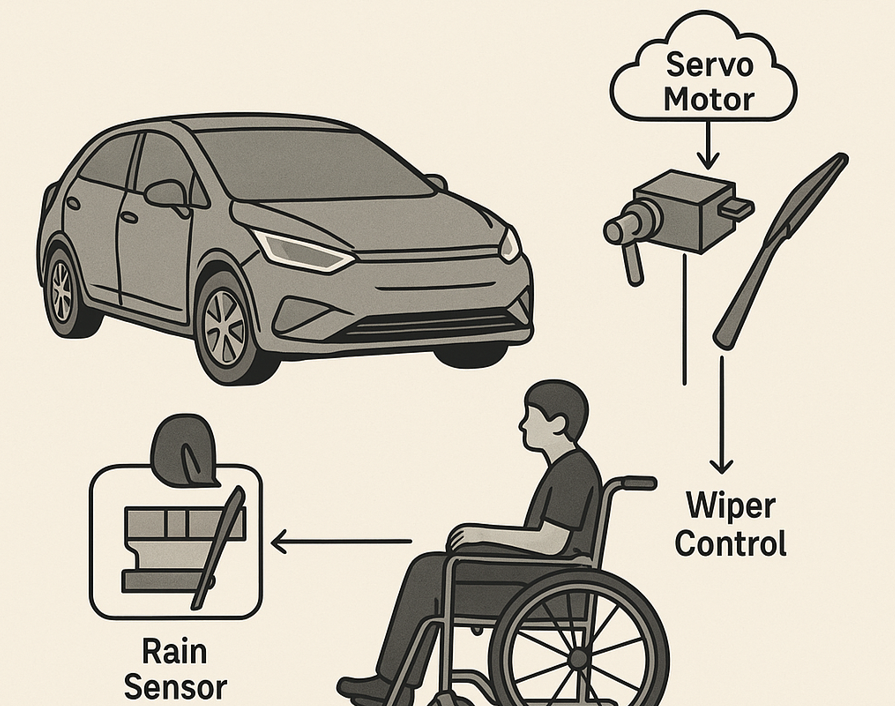Prototype of an Adaptive Wiper System for Electric Vehicles for Disabled Users Using a Servo Motor
DOI:
https://doi.org/10.21831/jamat.v2i1.1342Keywords:
Servo motor, Electric vehicle, Wiper system, Persons with disabilitiesAbstract
This study presents the design and implementation of a prototype wiper system using a servo motor, specifically developed for electric vehicles designed for persons with disabilities. The system is structured through several stages, including the creation of a wiring diagram, the development of a control system based on an Arduino Uno microcontroller, and the integration of key components such as a 12V battery, a three-position switch, a step-down LM2596 module, and an RDS3239 servo motor. The control logic enables two-speed wiping modes low and high regulated by user input via the switch. Electrical testing demonstrated that the current drawn by the system was 0.26 A at low speed and 0.37 A at high speed, with corresponding power consumption of 3.12 W and 4.44 W, respectively. These values fall within safe operating limits, indicating energy efficiency suitable for electric vehicle applications. Motion testing showed that the system achieved 30 wipes per minute at low speed and 60 wipes per minute at high speed, with the high-speed mode meeting the minimum functional criteria set by national standards. Angular deviation analysis further revealed that increased speed slightly impacted sweep precision, though still within acceptable tolerances. The results indicate that the developed system not only performs effectively in varying operational conditions but also offers energy-efficient and responsive functionality. This makes it a viable solution for adaptive and accessible mobility technologies in electric vehicles for persons with disabilities.
Downloads
References
[1] M. M. Sefotho and P. L. Leshota, "Being differently abled: Disability through the lens of hierarchy of binaries and Bitso-lebe-ke Seromo," African Journal of Disability, vol. 9, no. 1, pp. 1-7, 2020.
[2] R. Stoutjesdijk, E. M. Scholte, and H. Swaab, "Special needs characteristics of children with emotional and behavioral disorders that affect inclusion in regular education," Journal of emotional and behavioral disorders, vol. 20, no. 2, pp. 92-104, 2012, doi: https://doi.org/10.1177/1063426611421156.
[3] A. Waldschmidt and M. Sépulchre, "Citizenship: reflections on a relevant but ambivalent concept for persons with disabilities," Disability & Society, vol. 34, no. 3, pp. 421-448, 2019, doi: https://doi.org/10.1080/09687599.2018.1543580.
[4] A. de Beer, L. Naudé, and L. Nel, "From disabled to differently abled: A psychofortological perspective on first-year students living with disability," Indo-Pacific Journal of Phenomenology, vol. 23, no. 1, p. e2222938, 2023, doi: https://doi.org/10.1080/20797222.2023.2222938.
[5] G. Akyurek and G. Bumin, "Community participation in people with disabilities," Occupational therapy-occupation focused holistic practice in rehabilitation. Croatia: Intech, pp. 81-107, 2017.
[6] K. Vornholt et al., "Disability and employment–overview and highlights," European journal of work and organizational psychology, vol. 27, no. 1, pp. 40-55, 2018, doi: https://doi.org/10.1080/1359432X.2017.1387536.
[7] P. Thornton and N. Lunt, "Employment policies for disabled people in eighteen countries: A review," 1997.
[8] A. E. Dingil, "Fostering Inclusive Urban Transportation in Planning and Policy-Making: An Umbrella Review using ALARM Methodology," Sustainable Futures, p. 100420, 2024, doi: https://doi.org/10.1016/j.sftr.2024.100420.
[9] J. McClure and C. Leah, "Is independence enough? Rehabilitation should include autonomy and social engagement to achieve quality of life," Clinical Rehabilitation, vol. 35, no. 1, pp. 3-12, 2021, doi: https://doi.org/10.1177/0269215520954344.
[10] N. K. Ndwiga, "Design and Construction of A Microcontroller-Based Five Degree of Freedom Robotic Arm Using Servo Motors," Kenyatta University, 2018.
[11] R. Hassan and B. Abubakar, "Intelligent arduino based automatic solar tracking system using light dependent resistors (LDRs) and servo motor," Optics, vol. 9, no. 2, p. 13, 2020, doi: 10.11648/j.optics.20200902.11.
[12] R. Saidur, S. Mekhilef, M. B. Ali, A. Safari, and H. A. Mohammed, "Applications of variable speed drive (VSD) in electrical motors energy savings," Renewable and sustainable energy reviews, vol. 16, no. 1, pp. 543-550, 2012, doi: https://doi.org/10.1016/j.rser.2011.08.020.
[13] F. Xie, C. Qiu, and Z. Qian, "Optimal speed–torque control of asynchronous motor for electric cars in the field-weakening region based on voltage vector optimization," IEEE Transactions on Power Electronics, vol. 37, no. 1, pp. 830-842, 2021, doi: 10.1109/TPEL.2021.3097906.
[14] W. Cai, X. Wu, M. Zhou, Y. Liang, and Y. Wang, "Review and development of electric motor systems and electric powertrains for new energy vehicles," Automotive Innovation, vol. 4, pp. 3-22, 2021, doi: https://doi.org/10.1007/s42154-021-00139-z.
[15] I. Cataldo, "Electric Vehicle for Mobility of Disabled People in Indoor Public Environment," 2022, doi: https://doi.org/10.46254/EU05.20220275.
[16] A. D. Kroemer and K. H. E. Kroemer, Office ergonomics: Ease and efficiency at work. CRC Press, 2016.
[17] M. Dooner, "Modelling, real-time simulation and control of automotive windscreen wiper systems for electronic control unit development," 2016.

Downloads
Published
How to Cite
Issue
Section
License
Copyright (c) 2025 Journal of Automotive and Mechanical Applied Technology

This work is licensed under a Creative Commons Attribution 4.0 International License.








